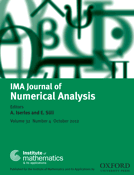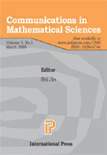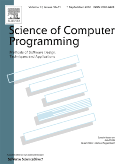
Bulletin of the South Ural State University Series-Mathematical Modelling Programming & Computer Software
Scope & Guideline
Fostering Collaboration in Mathematical Modeling and Software Development
Introduction
Aims and Scopes
- Mathematical Modelling:
The journal emphasizes the development and application of mathematical models to describe complex systems in various fields such as physics, engineering, biology, and economics. - Numerical Analysis and Computational Methods:
A core focus on numerical methods, algorithms, and computational techniques for solving differential equations, optimization problems, and simulations of dynamic systems. - Optimization Techniques:
Research on optimization strategies, including linear and nonlinear programming, parametric optimization, and heuristic methods, is prominently featured. - Stochastic Processes and Control Theory:
Investigation of stochastic models and control systems, addressing uncertainty and randomness in mathematical frameworks. - Software Development and Applications:
The journal includes papers on the design, implementation, and application of software tools and environments for mathematical modeling and computational experiments. - Interdisciplinary Research:
Encouraging interdisciplinary approaches that integrate mathematics with computer science, engineering, and physical sciences to address real-world challenges.
Trending and Emerging
- Machine Learning and AI in Modeling:
An increasing number of papers are integrating machine learning techniques with mathematical modeling, emphasizing data-driven approaches to problem-solving. - Inverse Problems and Parameter Estimation:
Research focusing on inverse problems, particularly in the context of parameter estimation in complex models, has gained prominence due to its applications in various scientific fields. - Complex Systems and Nonlinear Dynamics:
There is a growing interest in modeling complex systems that exhibit nonlinear dynamics, reflecting the need for advanced analytical and numerical techniques. - Environmental and Ecological Modeling:
Papers addressing environmental issues, such as ecological modeling and climate change impacts, are becoming more prevalent, indicating a trend towards applied mathematics in sustainability. - Neural Networks and Computational Intelligence:
The application of neural networks and other computational intelligence methods is emerging as a significant trend, particularly in areas like image processing and signal analysis. - Hybrid Computational Methods:
Research combining different computational methods, such as deterministic and stochastic approaches, is on the rise, showcasing the need for versatile solutions in complex problem domains.
Declining or Waning
- Classical Analytical Methods:
There has been a noticeable decline in papers focusing on purely analytical approaches to problem-solving, as the trend shifts towards numerical and computational methods. - Traditional Optimization Techniques:
Older optimization techniques that are not integrated with modern computational algorithms are appearing less frequently, indicating a preference for more advanced, hybrid approaches. - Basic Theoretical Studies:
The journal has seen fewer submissions that focus solely on theoretical explorations without practical applications or computational implementations. - Static Models in Favor of Dynamic Simulation:
Research centered on static or equilibrium models is decreasing, as dynamic modeling and simulation of systems gain more traction. - Single-Domain Applications:
There is a waning interest in papers that focus exclusively on applications within a single discipline, with a clear shift towards interdisciplinary studies.
Similar Journals

Mathematical Foundations of Computing
Unlocking the Power of Mathematics in ComputingMathematical Foundations of Computing, published by the American Institute of Mathematical Sciences (AIMS), is a distinguished open-access journal that has been actively disseminating influential research in the fields of Artificial Intelligence, Computational Mathematics, Computational Theory and Mathematics, and Theoretical Computer Science since its inception in 2009. With its E-ISSN 2577-8838, this journal is committed to providing researchers and practitioners with cutting-edge mathematical theories and methodologies that underpin modern computational practices, which is critical for advancing the field. The journal proudly holds a Q3 categorization in several relevant domains as of 2023, reflecting its contribution and accessibility amid an evolving academic landscape. By offering open access to its content, it ensures that vital research is freely available to a global audience, enhancing collaboration and innovation. Positioned in the heart of the United States, Mathematical Foundations of Computing serves as a crucial resource for advancing knowledge and fostering discussions among researchers, professionals, and students passionate about the mathematical underpinnings of computing.

Numerical Analysis and Applications
Advancing computational frontiers through numerical innovation.Numerical Analysis and Applications is a prominent journal dedicated to advancing the field of numerical analysis, published by the Siberian Branch of the Russian Academy of Sciences. Established in 2009, and running through to 2024, this scholarly publication serves as a vital resource for researchers, professionals, and students involved in the mathematical sciences. The journal’s impact is underscored by its classification in the Q3 quartile for numerical analysis within the latest metrics, reflecting its significance in the academic community, although it presently ranks 74 out of 88 in the numerical analysis category, representing a 16th percentile. With a broad scope that encompasses innovative methodologies and applications in numerical techniques, the journal aims to foster interdisciplinary collaboration and share pivotal advancements in numerical theory and practice. Access options may vary, thus offering opportunities for both traditional and contemporary researchers to engage with cutting-edge content that is crucial for driving forward the computational sciences.

CONSTRAINTS
Pioneering Research for the Future of Computational SciencesCONSTRAINTS, an esteemed journal published by Springer, specializes in the interrelated domains of Artificial Intelligence, Computational Theory and Mathematics, Discrete Mathematics and Combinatorics, and Software. With an ISSN of 1383-7133 and E-ISSN of 1572-9354, this journal provides a critical platform for disseminating cutting-edge research and methodologies aimed at addressing complex challenges in these rapidly evolving fields. Located in the Netherlands, the journal's rigorous selection process is reflected in its impressive categorizations, achieving Q2 and Q3 rankings in various Scopus categories for 2023. This positions it among the top quartiles in its respective fields, making it a vital resource for scholars and practitioners seeking to stay at the forefront of innovation. Researchers and students alike will benefit from the insightful contributions within its pages, making CONSTRAINTS a pivotal journal for those dedicated to advancing knowledge and application in computational and artificial intelligence spheres.

International Journal of Mathematics and Computer Science
Bridging Theory and Application in Mathematics and ComputingThe International Journal of Mathematics and Computer Science (ISSN: 1814-0424, E-ISSN: 1814-0432), published by Lebanese University, serves as a vital platform for disseminating innovative research and advancements in the fields of mathematics and computer science. With a compelling range of topics including Algebra, Applied Mathematics, Computational Mathematics, and Statistical Analysis, this journal caters to a broad audience of researchers, professionals, and students. Spanning the years from 2017 to 2025, it has established a presence in several key quartiles, including Q3 rankings in Applied Mathematics and Computational Mathematics, and a Q4 ranking in Algebra and Number Theory. While currently not an open-access journal, it provides valuable insights through its rigorous peer-reviewed process, enhancing its relevance in both theoretical and applied domains. Furthermore, its presence in Scopus rankings reflects its commitment to quality, making it an essential resource for anyone looking to explore the intersection of mathematics and computer science.

IMA JOURNAL OF NUMERICAL ANALYSIS
Elevating Research in Applied Numerical AnalysisIMA Journal of Numerical Analysis, published by Oxford University Press, stands as a premier platform for cutting-edge research in the field of numerical analysis, exemplifying the latest advancements and methodologies in applied, computational, and general mathematics. Since its inception in 1981, this esteemed journal has continually contributed to the academic community by publishing high-quality, peer-reviewed articles that foster innovation and collaboration among researchers. With an impressive Q1 ranking across multiple categories, including Applied Mathematics and Computational Mathematics, it plays a crucial role in disseminating knowledge, as indicated by its Scopus rankings which place it in the top 25% of journals within its field. Although the journal is not open access, it remains a vital resource for academics, professionals, and students eager to engage with the ongoing evolution of numerical methods. By serving as a conduit for novel ideas and rigorous research, the IMA Journal of Numerical Analysis ensures that its contributors and readers are at the forefront of this dynamic discipline.

ESAIM-Mathematical Modelling and Numerical Analysis
Exploring the Nexus of Theory and ApplicationESAIM-Mathematical Modelling and Numerical Analysis, published by EDP SCIENCES S A, is a prestigious open-access journal at the forefront of the fields of mathematical analysis, applied mathematics, computational mathematics, modeling, simulation, and numerical analysis. With an impressive Q1 ranking in multiple categories for 2023, the journal is recognized for its contribution to advanced research, particularly in areas that intertwine mathematical theory with practical applications. The journal’s ISSN is 2822-7840 and its E-ISSN is 2804-7214, showcasing its commitment to both traditional and digital dissemination of knowledge. Spanning from 1996 to 2024, ESAIM has established itself as a vital platform for scholars seeking to publish innovative research and engage with the latest advancements in the field. Researchers and practitioners can explore the journal’s content through various access options, fostering a collaborative environment for the sharing and development of new mathematical methodologies. Situated in France, ESAIM continues to attract an international readership, driving forward the global discourse in mathematical sciences.

PROGRAMMING AND COMPUTER SOFTWARE
Advancing Software Development Through Rigorous ResearchPROGRAMMING AND COMPUTER SOFTWARE is a distinguished journal committed to advancing the field of software development and programming methodologies. Published by PLEIADES PUBLISHING INC, this journal has been a valuable resource since its inception in 1978, reaching out to researchers, professionals, and students alike. With an emphasis on rigorous peer-reviewed articles, the journal holds a Q3 ranking in the realm of Software according to the latest 2023 Category Quartiles. Though it does not offer open access, the journal ensures that high-quality research is disseminated to its audience, providing insights into evolving programming techniques, software engineering challenges, and innovative solutions. With its convergence of years extending to 2024, PROGRAMMING AND COMPUTER SOFTWARE remains a pivotal publication, fostering a deeper understanding of the complexities in computer programming while supporting the broader software community.

APPLIED MATHEMATICS AND OPTIMIZATION
Pioneering Applied Mathematics for Practical SolutionsApplied Mathematics and Optimization, published by Springer, is a prestigious journal dedicated to the rigorous exploration of applied mathematics, optimization techniques, and their multifaceted applications. Since its inception in 1974, the journal has maintained a robust reputation within the academic community, achieving a commendable Q1 ranking in both Applied Mathematics and Control and Optimization categories as of 2023. With an impact factor that underscores its influence in the field, the journal provides a platform for researchers and practitioners to disseminate innovative methodologies and significant advancements. While it does not offer Open Access, the journal’s esteemed peer-reviewed articles serve as invaluable resources for the advancement of theoretical knowledge and practical applications. Researchers, professionals, and students alike will find Applied Mathematics and Optimization an essential source for staying at the forefront of mathematical sciences, particularly in optimizing real-world systems and processes.

Communications in Mathematical Sciences
Bridging Theory and Application in MathematicsCommunications in Mathematical Sciences is a prestigious journal published by INT PRESS BOSTON, INC, dedicated to advancing the field of mathematical sciences through the dissemination of high-quality research. Since its inception in 2003, the journal has established itself as a key platform for scholars in both applied and theoretical mathematics, evidenced by its impressive rankings, with a Q2 designation in Applied Mathematics and a Q1 status in Miscellaneous Mathematics categories as of 2023. Although not an open-access journal, it provides comprehensive access to groundbreaking studies that span a wide array of topics within mathematical sciences, making it invaluable for researchers, professionals, and students alike. The journal's strong performance metrics, including a Scopus rank that places it in the 64th and 38th percentiles for General and Applied Mathematics, respectively, highlight its influence and significance within the academic community. With an optimistic convergence towards future advancements by 2024, Communications in Mathematical Sciences continues to play a vital role in the growth and evolution of mathematical inquiry.

SCIENCE OF COMPUTER PROGRAMMING
Elevating Knowledge in Computer Programming and BeyondScience of Computer Programming, published by Elsevier, is a leading journal dedicated to advancing knowledge in the fields of computer programming, computational theory, and software development. With a focus on interdisciplinary research that spans computational methodologies, information systems, and simulation modeling, this journal plays a vital role in disseminating innovative findings and fostering collaboration among experts in these dynamic areas. With a respectable impact factor and ranked in various Scopus Categories such as computational theory (Q3) and information systems (Q2), it provides a platform for high-quality scholarly articles that push the boundaries of programming science. Although currently not open access, the journal offers invaluable insights for researchers, professionals, and students alike, ensuring they are equipped with the latest advancements and methodologies to thrive in an ever-evolving technological landscape. The journal covers research from its convergence starting in 1981 and continues to welcome groundbreaking contributions as it looks forward to an exciting future through 2025 and beyond.